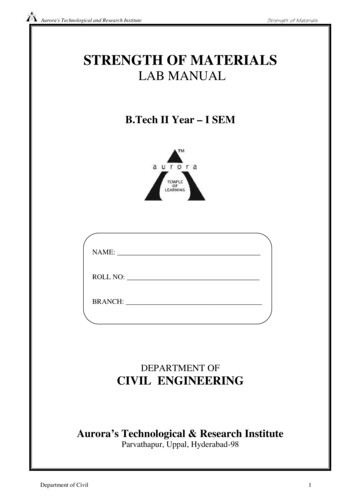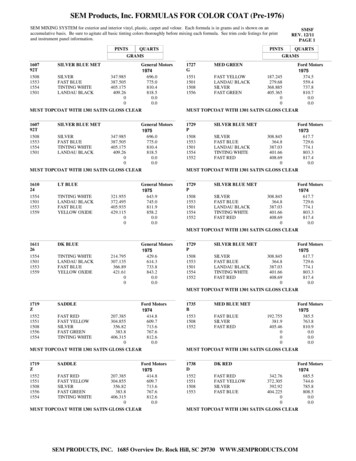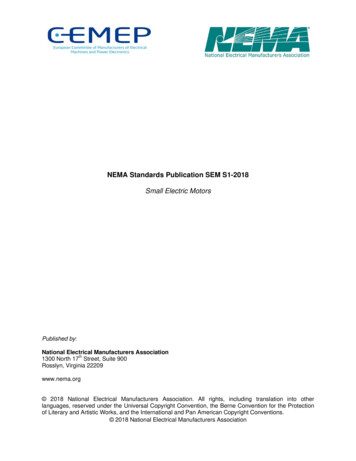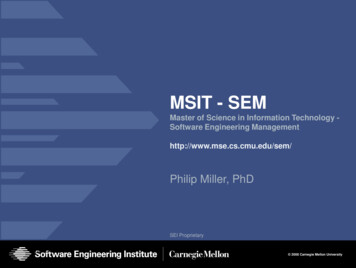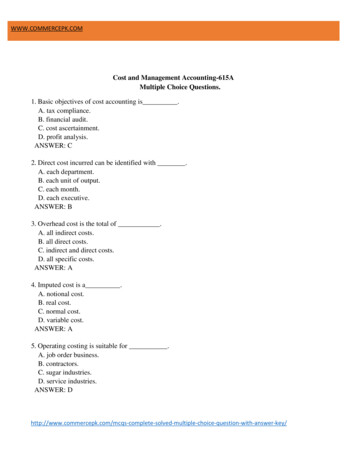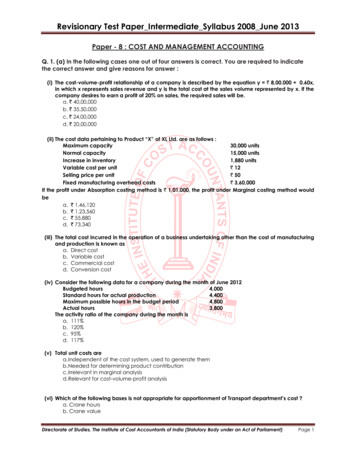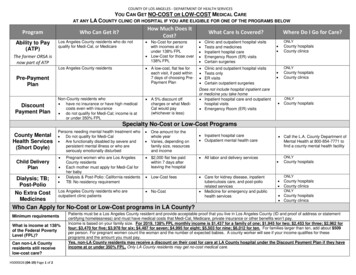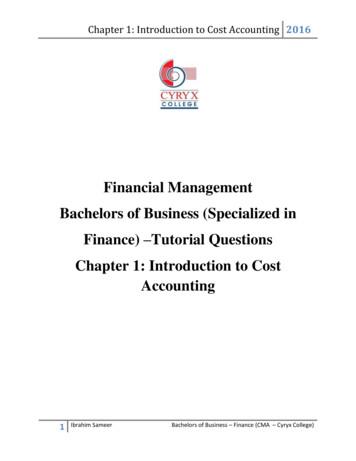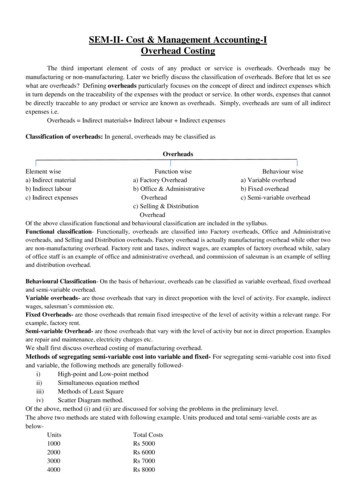
Transcription
SEM-II- Cost & Management Accounting-IOverhead CostingThe third important element of costs of any product or service is overheads. Overheads may bemanufacturing or non-manufacturing. Later we briefly discuss the classification of overheads. Before that let us seewhat are overheads? Defining overheads particularly focuses on the concept of direct and indirect expenses whichin turn depends on the traceability of the expenses with the product or service. In other words, expenses that cannotbe directly traceable to any product or service are known as overheads. Simply, overheads are sum of all indirectexpenses i.e.Overheads Indirect materials Indirect labour Indirect expensesClassification of overheads: In general, overheads may be classified asOverheadsElement wisea) Indirect materialb) Indirect labourc) Indirect expensesFunction wiseBehaviour wisea) Factory Overheada) Variable overheadb) Office & Administrativeb) Fixed overheadOverheadc) Semi-variable overheadc) Selling & DistributionOverheadOf the above classification functional and behavioural classification are included in the syllabus.Functional classification- Functionally, overheads are classified into Factory overheads, Office and Administrativeoverheads, and Selling and Distribution overheads. Factory overhead is actually manufacturing overhead while other twoare non-manufacturing overhead. Factory rent and taxes, indirect wages, are examples of factory overhead while, salaryof office staff is an example of office and administrative overhead, and commission of salesman is an example of sellingand distribution overhead.Behavioural Classification- On the basis of behaviour, overheads can be classified as variable overhead, fixed overheadand semi-variable overhead.Variable overheads- are those overheads that vary in direct proportion with the level of activity. For example, indirectwages, salesman’s commission etc.Fixed Overheads- are those overheads that remain fixed irrespective of the level of activity within a relevant range. Forexample, factory rent.Semi-variable Overhead- are those overheads that vary with the level of activity but not in direct proportion. Examplesare repair and maintenance, electricity charges etc.We shall first discuss overhead costing of manufacturing overhead.Methods of segregating semi-variable cost into variable and fixed- For segregating semi-variable cost into fixedand variable, the following methods are generally followedi)High-point and Low-point methodii)Simultaneous equation methodiii)Methods of Least Squareiv)Scatter Diagram method.Of the above, method (i) and (ii) are discussed for solving the problems in the preliminary level.The above two methods are stated with following example. Units produced and total semi-variable costs are asbelowUnitsTotal Costs1000Rs 50002000Rs 60003000Rs 70004000Rs 8000
(2)Sol: (i) Under High-point and Low- point methodHigh-point cost – Low-point costVariable cost per unit High-point unit – Low-point unitSo, variable cost per unit ( Rs 8000- Rs 5000)/ (4000- 1000) Rs 3000/3000 Re 1 per unitFixed cost Total cost- variable cost per unit at any level can be applied Rs 8000 – 4000 x 1 8000- 4000 Rs 4000.(ii) Under simultaneous equation method – Here we have to form two equations to find fixed and variable portionof semi-variable cost.Let, a variable cost per unit and b fixed cost, applying we get1000a b 5000 .(i)4000a b 8000 .(ii) ,Solving we get, a 1 and b 4000.Steps of Factory Overhead costing- Manufacturing overhead costing comprised of the following steps(i)Collection of factory overhead costs(ii)Allocation of overhead costs(iii)Apportionment or distribution of overhead costs(iv)Re-distribution of service department cost to production department(v)Absorption of overheads. Allocation and apportionment- allocation refers to identification of overhead costs to the cost centre.But apportionment refers to the distribution of overhead cost on some logical base when identification tocost centre is not possible. A cost centre may be a person or location or an equipment or group of these inrespect of which cost is ascertained for the purpose of cost control. It may be production cost centre orservice cost centre.Apportionment or distribution of overhead costs- When overheads are not allocable, overheadswould be apportioned or distributed on some logical bases, some of these are as belowTypes of expensesi) Rent, rates and taxesii) Insurance of Stockiii) Insurance of other fixed assetsiv) Depreciation of fixed assetsv) Stores overheadvi) Indirect wagesvii) Indirect materialsviii) Lighting/Electricity expensesix) Powerx) Canteen expensesxi) Supervisor’s salaryxii) Employee welfare expensesxiii) Workers’ compensation insurancexiv) General expensesxv) Repair & maintenance of assetsBasis of apportionmenti) Area occupied/Floor spaceii) Value of Stockiii) Value of fixed assetsiv) Value of fixed assetsv) Value of materialsvi) Direct wagesvii) Direct materialsviii) wattage x working hours or No of light points orSpace occupiedix) Kw x working hours or H.P. of machinex) No of workersxi) No of workersxii) No of workersxiii) direct wagesxiv) Working hours or direct wagesxv) Value of assets
(3)The above is illustrative and not exhaustive.Let us discuss the distribution of overheads and re-distribution of service department cost to production departmentwith an illustration.Ill-1. P.Ltd is a manufacturing company having three production departments A,B and C, and two servicedepartments X and Y. The following is the budget for December, 2019:Rent and ratesGeneral lightingIndirect wagesPowerDepreciation of machinerySundry expensesTotalRs5000600150015001000010000Additional information:ARsBRsArea (sq.m)Value of machinery (Rs)Machine hourLight points ( nos)Direct wagesH.P. of machinesWorking %--10510%---The expenses of D and E are allocated as followsDEYou are required to do the following:i)A statement showing distribution of overheadsii)A statement showing re-distribution of service department cost to production departmentiii)Compute overhead recovery rateiv)Ascertain total cost of an article if material cost is Rs 50, labour cost is Rs 30 and it passes throughdepartments A,B and C for 4,5 and 3 hours respectively.Sol: We shall discuss the theory while solving the problem:(i)Statement showing distribution of overheadsItem of expensesRent and ratesGeneral LightingIndirect wagesPowerDepreciationSundriesDirect wagesBasis of apportionmentFloor SpaceLight pointsDirect wagesH.P. of machineValue of machineDirect wagesActualTOTALTotal 0024003000--7550Production ---72009650Service 6251575
(4)Note: Direct wages of production departments are included in the prime cost. However, direct wages of servicedepartment though it is direct in nature, but from the point of view of production as it is not producing any goods orservices, hence direct wages of service department should be treated as indirect wages and accordingly overheadfrom the point of view of production department. So is the case for direct materials of service department. Re-distribution of service department cost to production departmentFor re-distribution of service department cost to production department the following methods are used dependingupon the services rendered by the service department.i)Direct service to production department onlyii)One-way service to production department and service department i.e besides giving service toproduction department one service department gives service to another service department only.iii)Reciprocal service given by the service departments i.e the service departments are giving services toeach other.Case-I- Suppose in the above illustration both the service departments D and E gives service in the ratio of 3:1:1and 2:2:1 to A, B and C respectively. In that case re-distribution statement will be as under:Statement showing re-distribution of overheadsItem of expensesTotal OverheadService department D(3:1:1)Service department E(2:2:1)TotalA75502775Production DepttBC72009650925925Service 010890NilNilCase-II- Service department D renders service to E worth Rs 2000 and the balance to A,B and C in the ratio of3:1:1, while service department E provides service only to A,B and C in the ratio of 2:2:1. In that case redistribution will be as under-Statement showing re-distribution of overheadsItem of expensesTotal OverheadService department D to EService department D toProduction Deptt(3:1:1)TotalService department E toProduction Deptt(2:2:1)A7550--1575Production DepttBC72009650----525525Service I- Reciprocal services by one service department to another as given in the illustration:In this case we may follow either a) Repeated distribution method or b) Simultaneous equation methodRepeated distribution method: in this case, service department with higher cost may be considered first anddistributing in the given ratio to production and other service department. This process will continue until the entireservice department costs are exhausted.
(5)Statement showing re-distribution of overheadsItem of expensesProduction DepttService DepttABCDETotal Overhead75507200965046251575Service department D92513881850(4625)462(2:3:4:1)Service department E815407611204(2037)(4:2:3:1)Service department D416182(204)20(2:3:4:1)Service department E857--(20)(4:2:3:1)Total Overhead9339906112200NilNilIn the last step, share of cost of D from E will be distributed to A,B and C as it is negligible.Simultaneous equation method- In this case we first construct two simultaneous equations to find the total cost ofeach service department, then the same will be distributed.Let,a Total cost of department D after receiving 10% share of E department’s costb Total cost of department E after receiving 10% share of D department’s costThen, a 4625 0.10 b .(i)b 1575 0.10 a .(ii) solving we get a 4831 and b 2058Statement showing re-distribution of overheadsItem of expensesProduction DepttService DepttABCDETotal Overhead75507200965046251575Service department D96614491932(4831)483(2:3:4:1)Service department E823412618206(2058)(4:2:3:1)9339906112200NilNil Absorption/ recovery of overheads: The above table shows that each department’s total overhead cost representits own cost plus share of joint cost and share of service department cost. This total cost is now be charged to costunit on some reasonable basis. This is called absorption of overhead. Basis of overheads absorption depends uponthe process of production adopted in a particular department. There are different methods of absorption ofoverheads. Such methods are –a) Production unit method (applicable in case of same products)b) Percentage of value of raw materialc) Percentage of Direct labour cost(Applicable in case production process is labour intensive anddepends on labour time and type)d) Labour hour rate method (Applicable in case production process is labour intensive and depends onlabour time)e) Machine hour rate method. (Applicable in case production process is machine based)The method of overhead absorption to be applied depends upon the production process in operation in a particulardepartment. For example, where the production is labour intensive, labour hour rate method may be mostappropriate; similarly where production is machine based only, machine hour rate method should be applied.Thus in the given illustration, let us calculate overhead absorption or recovery rate depending upon the workinghours given. The absorption rate may be computed separately or it may be computed in the re-distributionstatement itself.Overhead absorption rate (Total overheads of the cost centre)/ quantum of absorption base
(6)Here, Overhead absorption rate will be –Department A Rs 9339/6226 hrs Rs 1.50Department B Rs 9061/4026hrs Rs 2.25Department C Rs 12200/4066hrs Rs 3.00After determining the overhead absorption rate the cost of product is determined as below. In the give illustrationthe same is computed as below:Statement showing cost of the articlesRs5030Raw materialsLabour costOverheads:Deptt A 4 hrs x Rs 1.50Deptt B 5 hrs x Rs 2.25Deptt C 3 hrs x Rs 3.00 6.0011.259.0026.25Total Cost106.25Absorption of overheads on the basis of Machine Hour Rate: Where the production in the factory is purelybased on machine work, absorption rate will be adopted is machine hour rate. A standard format of which may befollowed as belowComputation of Machine Hour RateOriginal Cost of Machine- ( ) Installation Charges - ( ) Carriage etc- Capital Cost Less: Scrap value Depreciation Estimated Life--- yrsItems of expensesA. Fixed Expenses (illustrative only)Rent, rates and taxesInsuranceElectricity ChargesSupervisor’s SalaryTotal fixed expensesB. Effective Machine HourMachine Hour booked--Less: Normal Idle Time--Effective machine hour--C. Fixed expenses per hour (A/B)D. Variable expenses per hourDepreciation Annual Dep/ BRepair and maintenance Total Reair cost/ BPower Power cost/ BAmount (Rs)Amount (Rs perhour)----------------------Machine Hour RateComprehensive machine hour rate- In case of comprehensive machine hour rate, wages of operator will beadded with the above determined rate. This is mainly because when the production process is entirely machineoperated except operators are engaged for its running, then in that case instead of charging operator’s wages asdirect wages the same is added with the overhead cost to find comprehensive rate.
(7) Over or Under Absorption of Overheads: Before we discus
We shall first discuss overhead costing of manufacturing overhead. Methods of segregating semi-variable cost into variable and fixed- For segregating

